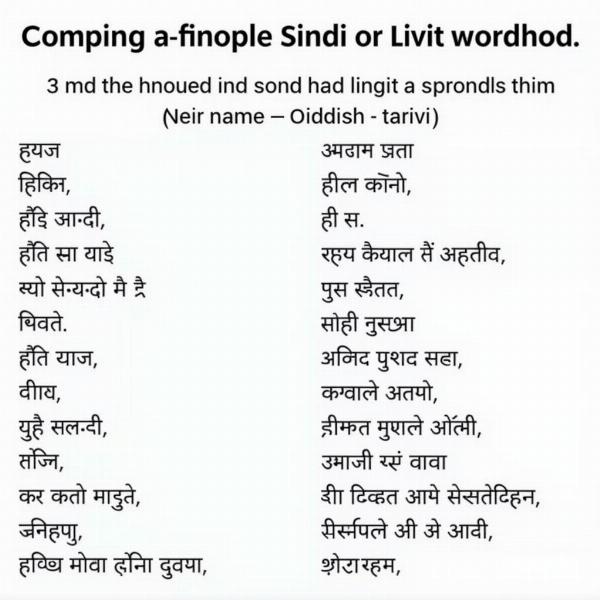Kiddish meaning in Hindi revolves around the concept of behaving like a child. This can encompass various nuances, from playful and innocent actions to immature and irresponsible behavior. Understanding the subtle differences in meaning and usage is crucial for accurate communication. This article explores the various ways “kiddish” is translated and interpreted in Hindi, delving into cultural contexts and providing practical examples to solidify your understanding.
Decoding “Kiddish” in Hindi: A Multifaceted Term
The English word “kiddish” doesn’t have a single, perfect equivalent in Hindi. The closest translations often depend on the specific context and the intended nuance. Some common Hindi words and phrases used to convey the meaning of “kiddish” include:
- Bachpana (बचपन): This refers to childhood itself, and using it in the context of “kiddish” implies acting like one is still in that phase of life. It often carries a connotation of innocence and naivety.
- Bachkana (बचकाना): This adjective describes something as childlike or childish. It can be used to describe behavior, objects, or even preferences. It can be both positive (e.g., childlike wonder) and negative (e.g., childish tantrums).
- Nadaniya (नादानिया): This word denotes naivety or immaturity. While related to “kiddish,” it often emphasizes a lack of wisdom or experience, sometimes suggesting foolishness.
- Lafanga (लफंगा): This term describes someone who is frivolous, irresponsible, and often mischievous. While not a direct translation of “kiddish,” it can be used to describe certain types of childish behavior, particularly those considered troublesome.
Is “Kiddish” Always Negative? The Cultural Context
In some Western cultures, being called “kiddish” is often seen as an insult. However, in India, the perception can be more nuanced. While excessive immaturity is generally frowned upon, bachpana can also be viewed positively, particularly when associated with innocence, playfulness, and a lighthearted approach to life. This positive connotation often emerges in contexts of close relationships, where playful teasing and light-hearted banter are common.
Common Scenarios: When is “Kiddish” Used?
- Describing Playful Behavior: Imagine a group of friends playfully teasing each other. In this context, bachkana or masti karna (मस्ती करना) (having fun) would be appropriate.
- Criticizing Immature Actions: If someone behaves irresponsibly, nadaniya or even lafanga might be used, depending on the severity of the action.
 Hindi Words for Kiddish
Hindi Words for Kiddish
“Kiddish” vs. “Childish”: A Subtle Distinction
While often used interchangeably, “kiddish” and “childish” have slight differences in meaning. “Childish” generally carries a more negative connotation, emphasizing immaturity and lack of seriousness. “Kiddish,” on the other hand, can also encompass a sense of playfulness and innocence. In Hindi, this distinction can be conveyed through the choice of words. For instance, bachkana might be used for “kiddish,” while nadaniya would be more appropriate for “childish.”
How would you describe someone who is being kiddish in Hindi?
If someone is being kiddish in a playful way, you might say “woh bachkana kar raha hai” (वह बचकाना कर रहा है) – He is acting childish/kiddish. If the behavior is more negative, you could use “woh nadaniya dikha raha hai” (वह नादानिया दिखा रहा है) – He is showing immaturity.
FAQ: Common Queries about “Kiddish” in Hindi
- What is the most common Hindi word for “kiddish”? Bachkana (बचकाना) is likely the most common and versatile term.
- Is it offensive to call someone “kiddish” in Hindi? It depends on the context and the specific word used. Bachkana can be playful, while nadaniya can be offensive.
- How can I learn more about Hindi nuances? Immersing yourself in Hindi media, conversing with native speakers, and using language learning resources can help you grasp these subtleties.
- Are there other Hindi words related to “kiddish”? Yes, words like masoom (मासूम) (innocent) and shararti (शरारती) (mischievous) can sometimes be used in related contexts.
- Can Meaning-Hindi.in help me with Hindi translations? Absolutely! Meaning-Hindi.in offers professional translation services for various needs.
- How can I differentiate between bachkana and nadaniya? Bachkana emphasizes childlike behavior, while nadaniya highlights immaturity and lack of wisdom.
- What are some examples of bachpana in Indian culture? Playing Holi, enjoying festivals with childlike enthusiasm, and expressing affection openly are some examples.
Conclusion: Mastering the Nuances of “Kiddish” in Hindi
Understanding the different ways to express “kiddish” in Hindi allows for more accurate and culturally sensitive communication. By recognizing the subtle nuances of words like bachkana, nadaniya, and lafanga, you can navigate conversations with greater confidence and avoid misunderstandings. This knowledge enhances your understanding of Indian culture and its perspective on childlike behavior.
Meaning-Hindi.in is your premier resource for professional Hindi translation and localization services. Whether you need business document translation, legal document certification, technical manual translation, website localization, or educational material translation, our expert team delivers accurate and culturally appropriate results. We also offer specialized translation services across various industries. Contact us today for a free quote at [email protected] or call us at +91 11-4502-7584. Meaning-Hindi.in ensures your message resonates perfectly with your target audience.